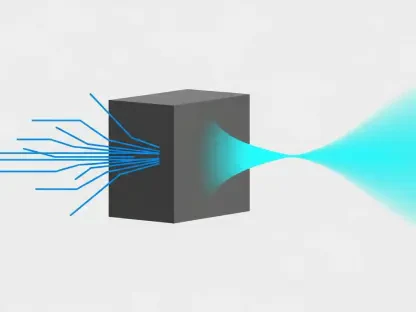In a groundbreaking development, a research team from the Columbia University School of Engineering and Applied Science has pioneered the creation of flexible, lightweight, radio-frequency (RF) communications antennas using a flat-knitting technique. This team was led by Associate Professor Nanfang Yu, and they have successfully merged their expertise in metasurfaces with scalable, cost-effective flat-knitting processes. This innovation aims to replace heavy, cumbersome satellite antennas with lightweight and foldable counterparts, particularly beneficial for individuals in remote locations.
Innovation in Knitting and Weaving
The Role of Knitting Techniques
The research focused on knitting and weaving techniques as the key to integrating antennas into textiles. Knitting, especially the float-jacquard technique, allowed the team to construct intricate antenna patterns directly within the fabric. This method, which is reminiscent of traditional Fair Isle sweaters, involves using multiple types of yarn to create patterns. The process is effective in producing complex array antennas with engineered electromagnetic responses.
The float-jacquard knitting technique stands out for its ability to create detailed and precise patterns necessary for the functionality of RF antennas. By embedding the antenna patterns directly into the fabric, the researchers have ensured that the antennas are not only functional but also durable and resistant to common issues like delamination, slip, or cracking. The seamless integration of antennas into the textile eliminates the need for adhesive or bonding agents that can often fail under environmental stress, further improving the reliability and longevity of the antennas.
Advantages of Textile-Based RF Antennas
Traditional RF antennas are usually rigid, heavy, and expensive to manufacture. In contrast, knitting techniques offer a flexible, lightweight, and more economical alternative. Integrated into textiles during the fabrication process, these antennas avoid issues related to quasi-additive approaches like inkjet or screen-printing. The scalability and cost-effectiveness of knitting make it a practical solution for mass-producing these antennas, which is essential for large-scale deployment.
This approach not only reduces the weight and bulk of the antennas but also makes them easier to transport and deploy, especially in remote or challenging environments. The integration of antennas into textiles represents a significant advancement in RF communications, offering the potential to revolutionize the way satellite communications systems are designed and implemented. The reduced manufacturing costs and enhanced durability further position these textile-based antennas as a superior alternative to traditional methods.
Prototypes and Testing
Development of Prototype Devices
The researchers developed two prototype devices: a metasurface lens (metalens) and a vortex-beam generating device. These prototypes were produced using commercially available metallic and dielectric yarns with existing knitting machinery. The use of readily available materials and machinery underscores the practicality and scalability of this innovative approach, ensuring that the process can be easily replicated and implemented on a commercial scale.
Testing showed that these prototypes performed well. The metalens, for instance, was capable of focusing an incident wave into a tight focal spot when receiving and converting divergent emissions into a planar wavefront when transmitting. This capability is crucial for enhancing the efficiency and effectiveness of satellite communications. The ability to focus and direct RF signals with such precision is a testament to the potential of these textile-based antennas in real-world applications.
Performance and Capabilities
The vortex-beam generating metasurface could produce a beam with a corkscrew-shaped wavefront, allowing it to carry an independent channel of information. This feature effectively doubles the efficiency of communication channels, making it a valuable asset for modern telecommunications. By enabling multi-channel communication within the same frequency band, these textile-based antennas can significantly enhance data transmission rates and overall network performance.
The successful testing of these prototypes demonstrates the potential of textile-based RF antennas to meet the demands of contemporary communication systems. The ability to produce complex beamforming and multi-channel communications using knitted textiles represents a significant leap forward in the field. Furthermore, the adaptability of the knitting technique allows for the creation of customized antenna designs tailored to specific applications, expanding their utility even further.
Scalability and Potential Applications
Large-Scale Production Capabilities
The scalability of flat knitting is a notable advantage. Commercial flat-knitting machines can produce textiles up to two meters wide without length restrictions, opening up possibilities to create large, high-gain antennas for vast-distance communication. This capability is particularly important for applications requiring extensive coverage and high performance. The ability to manufacture large-area antennas with high gain in a cost-effective manner positions this technology as a game-changer in the satellite communications industry.
The large-scale production capabilities of flat knitting machines make this approach particularly promising for future technologies requiring large-area, lightweight, and portable RF communication solutions. The ability to produce these antennas on a large scale ensures that they can be deployed widely and effectively, meeting the growing demand for advanced communication systems in various sectors. The versatility of the knitting process also allows for the integration of additional functionalities, such as sensors or electronic circuits, further enhancing the potential applications of these textile-based antennas.
Future Applications and Integration
Possible applications include lightweight and stowable antennas for satellites, enhancing their ability to communicate across vast distances. There is also potential for integrating these RF antennas with other functionalities, such as electronic circuits, into textiles to facilitate deployment and storage further. This integration opens up new possibilities for wearable technology and other innovative applications, providing seamless connectivity and communication capabilities in a variety of use cases.
From everyday consumers requiring WiFi signal boosters to advanced satellite communication systems, the potential uses for these textile-based antennas are vast and varied. The ability to incorporate RF communication capabilities directly into clothing or other fabric-based products could revolutionize how we think about and interact with technology. The research team’s innovative approach has paved the way for a new era of flexible, functional, and scalable RF communication solutions that have the potential to transform multiple industries.
Overarching Trends and Consensus Viewpoints
Interdisciplinary Approaches in Innovation
The study reflects a trend towards integrating advanced technologies into everyday materials, making sophisticated devices more accessible and practical. The convergence of traditional knitting techniques with modern RF technology exemplifies this trend, highlighting the importance of interdisciplinary approaches in innovation. By leveraging established practices and modern advancements, the researchers have showcased the potential to create transformative solutions that address current technological challenges.
Leveraging established, low-cost manufacturing methods to meet the growing demand for flexible and functional technologies is a key takeaway from this research. The consensus is that such approaches can significantly advance the field of telecommunications and other related areas. This fusion of art and science underscores the importance of creativity and collaboration in driving innovation, making it imperative for researchers and engineers to look beyond conventional methods and explore new avenues for development.
Practical Solutions for Modern Challenges
In an innovative stride, a research team from the Columbia University School of Engineering and Applied Science has developed flexible, lightweight radio-frequency (RF) communication antennas through a flat-knitting technique. Led by Associate Professor Nanfang Yu, the team combined their expertise in metasurfaces with scalable, cost-effective flat-knitting processes. This groundbreaking approach seeks to replace heavy, bulky satellite antennas with lightweight, foldable versions. The new antennas can be particularly beneficial for people in remote locations where traditional antennas are unwieldy and impractical. By making antennas more portable and easier to deploy, this advancement could revolutionize how satellite communications are conducted, enhancing accessibility and efficiency. The flexible design allows for easier transportation and setup, potentially transforming communication infrastructures in both civilian and military applications. This innovation fosters improved global connectivity, providing critical communication support in previously inaccessible areas and offering promising advancements in the field of RF communications.









